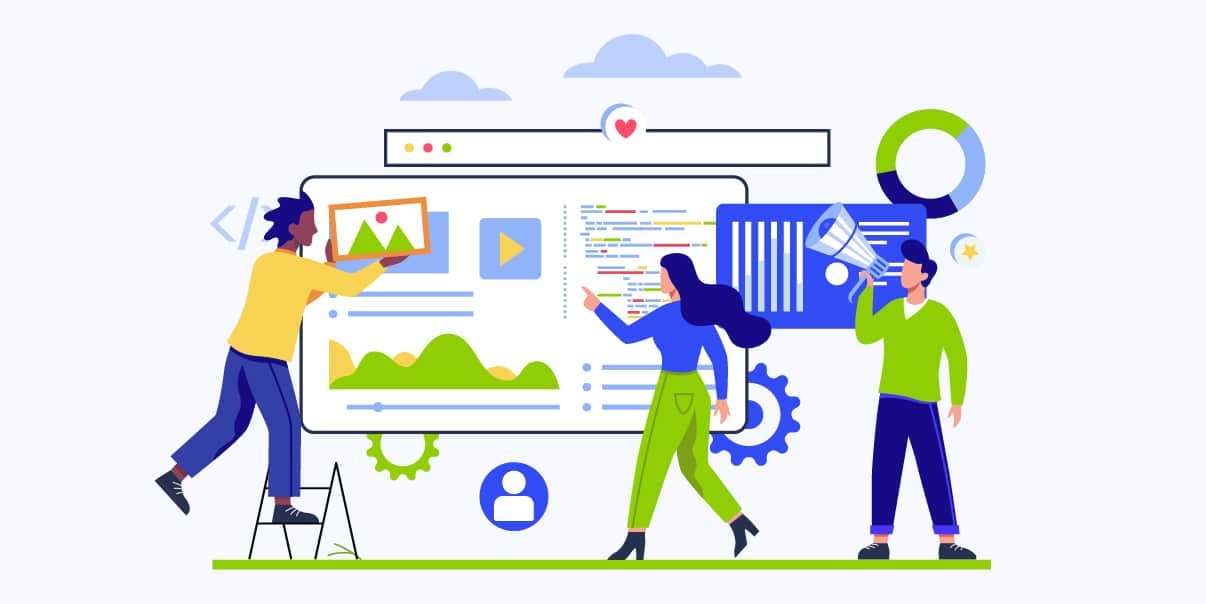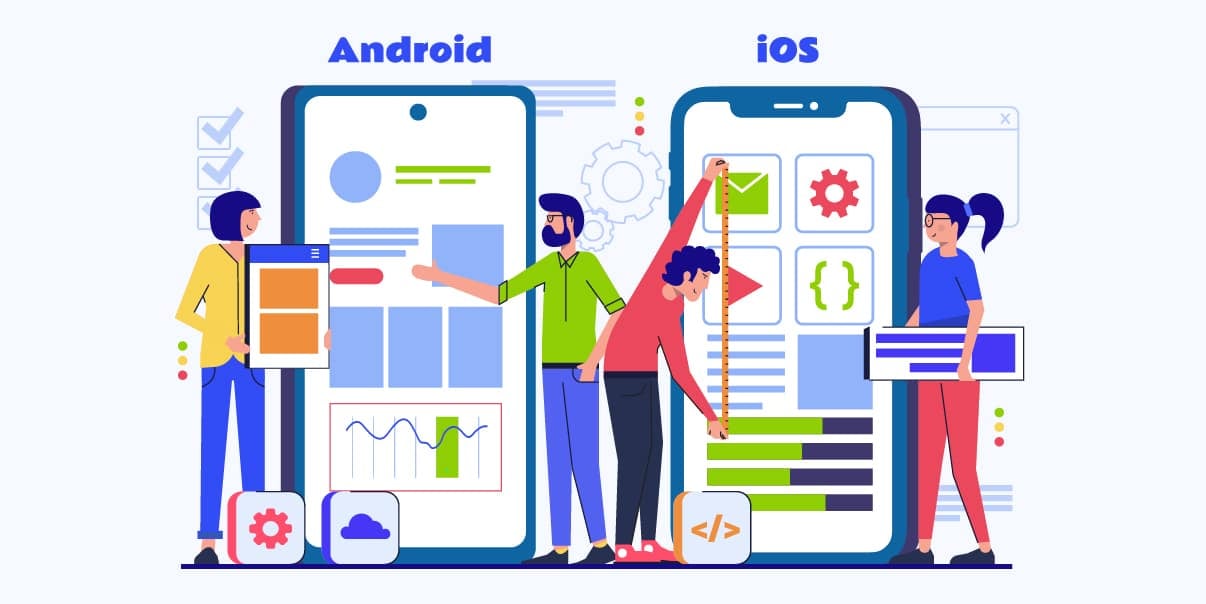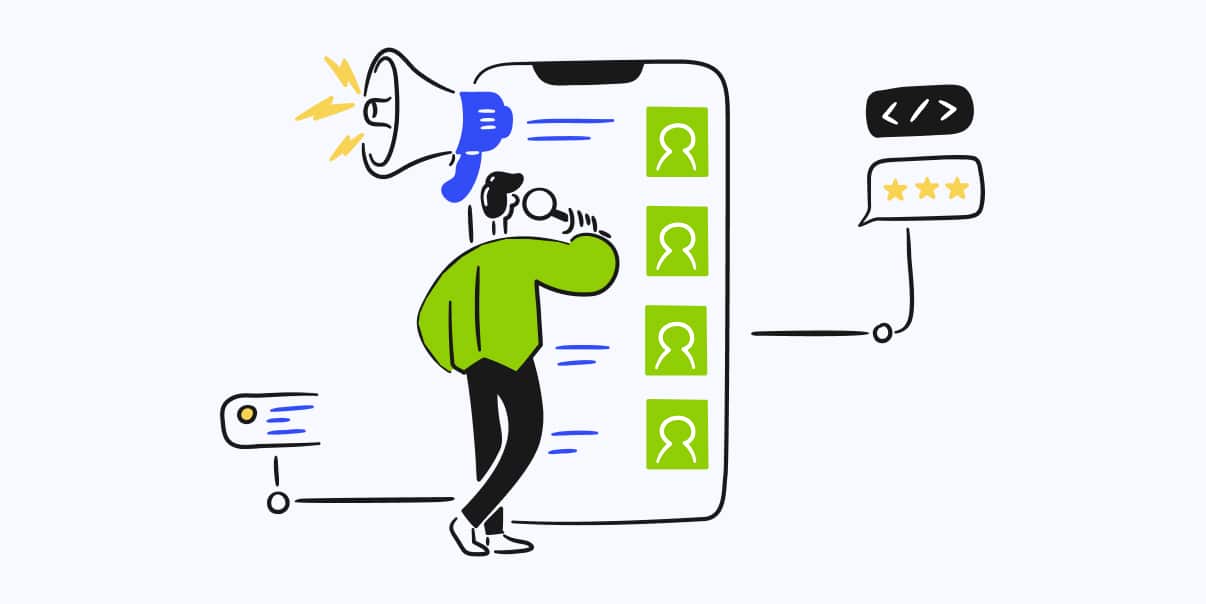Web Application Development: The Ultimate Guide for 2023

Businesses are increasingly turning to web application development to gain a competitive edge. But creating and maintaining robust and feature-rich web apps takes work.
This blog post will discuss the tools and resources to build top-notch web apps. We’ll share development tools and frameworks, best practices, and tips for creating powerful apps.
Whether you’re new to the idea or have plenty of experience, we’ll help you get up to speed with the latest web app development techniques. You’ll soon create top-notch web apps that users can trust, rely on, and enjoy. Let’s dive in!
Web Application Development in a Nutshell
Web app development is the process of creating web applications that are accessible via web browsers. Let’s break this definition down even further.
What Is a Web Application?
A web application (web app) is a software program accessed and used online. It’s stored on a remote server, not your computer or device. Examples of web apps include:
- Social media networks
- Online gaming platforms like Xbox Live
- Email services and calendar programs
- Shopping sites like Amazon
- Business productivity tools
What Is Web Application Development?
Web application development is the process of creating web apps. It requires planning, coding, and testing to ensure the app looks great and works well.
Web app developers use different programming languages and frameworks to create web apps that users will use and enjoy. Some popular web application frameworks include Angular and Vue.js. Developers also use React, a JavaScript library for building user interfaces.
Web app development is about creating reliable, secure, scalable, and user-friendly applications.
The Importance of Web App Development in Today’s Digital Age
Developing custom web apps is more critical than ever. Here are a few reasons why:
- Web apps help businesses reach customers and clients worldwide.
- These apps can process data faster than other types of software programs.
- They offer users convenience and flexibility. Plus, they don’t have to worry about software installation and updates.
- Web apps empower businesses to stay competitive in an ever-changing digital landscape.
Now that you know the basics of developing web apps, let’s dive into tips for building robust web apps.
Types of Web Applications
![Types of Web Applications [Infographics]](https://www.bitstudios.com/wp-content/uploads/2023/06/Web-Application-Development.jpeg)
Web apps come in different shapes and sizes. Here are the most popular types of web apps:
Static Web Applications
Static web apps are read-only and don’t require user input. These apps help businesses display information to website visitors quickly and accurately. Some examples of SWAs are informational websites like company overviews, portfolios, or news sites. SWAs are also ideal for weather forecasts, sports scores, and internal dashboards for tracking data.
There are many benefits to building SWAs. For example, you can create them without any backend infrastructure. It means you can deploy them much more quickly than traditional web apps. They also require less server space and fewer resources compared to dynamic web applications.
Dynamic Web Applications
Dynamic web apps (DWAs) are interactive and require user input. They typically involve databases for storing, retrieving, and manipulating data. Examples include online banking sites, travel booking services, and e-commerce stores.
DWAs offer several advantages over other types of web apps. For example, they tend to have better performance and scalability. Developers can also customize these apps to meet users’ needs more efficiently. Also, you don’t need to update DWAs as often since they run on databases.
Single-page Applications (SPAs)
Single-page applications (SPAs) are web apps that fit on a single page. Users can interact with SPAs without refreshing the page, reducing loading time between user interactions. This feature makes SPAs more user-friendly and convenient.
Developers use JavaScript frameworks like React or Angular to create SPAs. SPAs make it possible to build high-performance web apps in record time. Also, they only require a few server resources. That’s why SPAs are a top choice for business applications and online services like Airbnb or Uber.
Progressive Web Applications (PWAs)
PWAs combine the best features of traditional website applications with mobile app functionality. It means PWAs offer users a native experience while still being accessible online. Plus, they can work offline or with low-quality network connections. They also don’t require installation or updates like typical mobile apps. They offer users a native experience while still being accessible online. Plus, they don’t require installation or updates like regular mobile apps.
Some benefits of PWAs include faster loading speeds and improved user engagement. They’re suitable for online shopping or streaming services like Netflix.
Hybrid Web Applications
Hybrid web apps combine the features of SWAs, DWAs, SPAs, and PWAs. Developers can use HTML5 or other front-end technologies to create a native-like user experience.
One of the advantages of hybrid web apps is that they combine different types of web apps into one package. It means HWAs are easier to develop, maintain, and update. Plus, you can use them online and offline.
Real-time Web Applications
Real-time web applications (RTWAs) are suitable for messaging, gaming, or collaboration services. They enable users to interact with each other in real time.
Famous examples of RTWAs include video conferencing tools like Zoom or Slack. RTWAs help businesses stay productive and connected even when they’re working remotely. Also, they offer users an engaging and interactive experience.
Cloud-based Web Applications
Cloud-based web applications (CBWAs) are apps that run in the cloud. You can access these apps from any device with an internet connection.
CBWAs offer many advantages over traditional web apps. For example, they require minimal server resources and can scale to meet user demand. They’re also more secure and reliable since they run on the cloud. Common examples of CBWAs include Dropbox or Google Docs.
E-Commerce Web application
E-commerce web apps allow businesses to build an online store. They provide an easy way to sell products and services online.
Developers can use tools like WooCommerce or Shopify to create a customized e-commerce website. These apps offer features like payment processing, inventory tracking, order fulfillment, and more. They’re also secure and reliable.
Portal Web Application
Portal web applications enable users to interact with different websites and data sources. They make it easy for people to access multiple online services from a single website without logging in individually.
Facebook and Google are famous examples of portal web apps. Users can access emails, calendars, contacts, and other services from a single platform.
Portal web apps offer businesses many advantages. For example, they can increase customer engagement and loyalty. Not to mention they’re convenient for users and easy to maintain.
Animated Web Applications
Animated web applications add visual appeal to websites and apps. They help businesses create engaging user experiences by adding a layer of animation.
Animated web apps are great for marketing campaigns, tutorials, or educational material. Developers can use these apps to create interactive presentations or product demos.
You can also use AWAs to create interactive games or puzzles. They offer businesses a great way to engage with and entertain customers.
Rich Internet Web Applications
Rich Internet web applications (RIWAs) offer users a more interactive experience. They have features like drag-and-drop or real-time data streaming, which traditional web apps can’t match.
These apps are ideal for collaborative projects or data visualization. RIWAs make it easier to work with large amounts of data by visualizing it interactively. Examples of RIWAs include online mapping tools like Google Maps or financial dashboards.
Now that you know the different types of web apps, let’s talk about how to create them. Let’s start with frameworks and other web app development must-haves.
Web Application Development Frameworks and Technologies
Web application development frameworks are tools developers use to create web apps. They come with pre-built modules, components, and libraries, which streamline coding.
Here are the different web application framework types:
Server-side Frameworks
Developers use server-side frameworks to create web servers. These frameworks let you write code without worrying about the underlying infrastructure. Examples of server-side frameworks include Laravel for PHP, Spring Boot for Java, ASP.NET for .NET, Ruby on Rails for Ruby, and Express for Node.js.
Client-side Frameworks
Client-side frameworks help developers create a user interface that visitors can interact with. They come with features like buttons and forms, allowing developers to build web apps quickly. Examples include Angular, React, and Vue.js.
Database Management Systems
Database management systems store data securely in the cloud or on your server. They’re vital for creating dynamic web apps as they let you access large data repositories. Some examples of relational database management systems are MySQL and Oracle. Meanwhile, MongoDB and Cassandra are examples of NoSQL database management systems.
Testing Frameworks
Testing frameworks let you test web apps for bugs and other issues. They help developers find and fix problems before the app’s release so that it works as expected. Examples include Selenium, Robot Framework, and Cypress.
Integrated Development Environments (IDEs)
Integrated development environments (IDEs) are a complete set of tools for coding and debugging. They come with themes, plugins, and other features to streamline a developer’s workflow. Visual Studio Code, Sublime Text, and Atom are famous examples of IDEs.
That’s it for web application development frameworks and technologies! Now let’s talk about how to build robust and useful web apps.
Web Application Development Process: How To Build High-Performance Apps
Creating high-performance web apps requires careful planning and a well-defined process. Here are the steps involved in web application development:
Planning and Requirements Gathering
Starting a web app project requires a clear understanding of what you must do. To achieve this, you must get feedback from stakeholders, check out existing solutions, and consider the rules you must follow. You can use these insights to create a detailed plan with goals, deadlines, and milestones.
Designing and Prototyping
Designing and prototyping are the next steps in the web app development process. At this stage, you’ll create a mockup of your application and define its design, features, user flow, and layout. This step helps stakeholders see how the final product will look.
Development and Testing
Development is the next step in the web application development process. Here, you’ll write code and build the app according to your plan. You should test your app after every development phase to ensure it’s functioning as expected.
Deployment and Maintenance
Deployment is the final phase of web application development. It’s where you’ll take your app live and make it available for users. You should also monitor and maintain your app regularly. Doing so ensures your program is running smoothly and performing optimally.
Optimization and Scalability
Optimizing and scaling your app is essential for staying competitive. Here, you’ll monitor the performance of your application and make changes to improve it. It would be best to plan for future needs and scalability requirements.
Quality Assurance
Quality assurance (QA) is critical to web application development. It involves testing the web app against industry standards and expectations. Before releasing your web app, you should check for bugs or issues.
User Acceptance Testing
Web app development also includes user acceptance testing (UAT). This phase involves putting your web application before users and getting feedback. You should fix any issues and make improvements suggested by the testers.
Performance Optimization
The web app development process goes beyond maintenance and support. It also involves performance optimization. This phase is about making sure web apps run efficiently. The goal is to reduce loading times and optimize the code to improve the app’s performance.
Security Testing
Security testing is essential for web app development. You must ensure your web application follows industry-standard security protocols and measures. This step helps keep user data safe and secure from malicious actors.
Version Control
Version control is a vital web application development practice. It lets developers track changes and revert to previous versions of the app if necessary. This step makes web apps easier to manage and ensures they remain consistent.
Continuous Improvement
Continuous improvement should be part of web app development. It involves improving web apps over time with the help of user feedback and testing. This step helps web apps remain relevant, secure, and feature-rich.
Now that you know how to build web apps, let’s discuss best practices and tips for improving their performance.
Web Application Development Best Practices
Developing web applications requires knowledge, experience, and skill. Here are web app development best practices to keep in mind:
Prioritize Security
Security should be your top priority when creating web apps. Apps must be safe from malicious actors and follows industry-standard protocols. You should also ensure your authentication and authorization protocols are robust.
Here are other measures you can take to enhance security:
- Encrypt sensitive data transmissions
- Use HTTPS connections
- Install proper antivirus software.
For example, a bank may need to follow regulations that require advanced security measures to protect consumer data. Similarly, a healthcare provider must encrypt patient records according to HIPAA standards.
Follow the Principle of Least Privilege
The Principle of Least Privilege (POLP) is a security best practice. It states that users should have the minimum necessary access rights and privileges to perform their duties. POLP helps protect against unauthorized access, privilege escalation, and other threats.
For example, an online store employee can only access payment processors they need to do their job. They don’t need extra privileges like access to customer records or financial information. This step helps reduce the chance of data breaches or misuse of information.
Use HTTPS and SSL Certificates
HTTPS and SSL certificates are essential for web application security. They help ensure secure server and browser communication, preventing eavesdropping and man-in-the-middle attacks.
You should install an SSL certificate for your web app, even if it doesn’t require visitors to enter sensitive info like credit card numbers or passwords. This step helps ensure secure communication and builds trust with users.
Design a Scalable Architecture
Designing a scalable architecture is essential for web app development. It would help if you planned for future needs and scalability requirements. This step ensures your web app can handle increased traffic and other demands as it becomes more popular.
Perform Automated Testing
Automated testing is a must for web application development. It helps developers identify and fix potential issues before the app’s release. Automation also saves time, allowing you to focus on other tasks. But automated testing should complement, not replace, manual testing. Using both helps ensure comprehensive coverage and identification of potential issues.
Leverage Authentication & Authorization APIs
Authentication and authorization APIs are a must for creating secure web apps. They enhance security by authenticating users and authorizing access rights. This step helps protect user data from unauthorized access and malicious actors.
Implement Access Controls
Access controls are another critical security measure for web applications. It would help if you used access control measures to define who can view and edit your app’s data. For example, you can limit user access to specific pages or features within the application.
Securely Store Credentials and Passwords
It would be best to store all credentials and passwords securely. Never keep them in plain text; use encryption, hashing, and salting techniques to protect sensitive information. Regularly update and change passwords as needed.
Strengthen System Configurations and Defaults
Strengthening system configurations and defaults is critical for web application security. This step involves ensuring you follow industry-standard protocols. Doing so helps protect against common threats like SQL injection attacks or cross-site scripting. It’s also best to implement security headers to protect your web app from various attacks and vulnerabilities.
Utilize Error Handling and Logging
Error handling and logging are essential for web app development. This step involves tracking errors so you can quickly identify and fix any problems that crop up. It also helps generate reliable performance metrics showing how the app performs over time.
Common Challenges in Developing Web Applications and Solutions
Building web apps can be a daunting task. You must consider various factors, including security, scalability, performance, and more. Here are six common challenges developers face in creating web apps and their solutions:
Security Issues
Web applications must be secure from malicious actors and data breaches. So it’s essential to plan for how you’ll protect your app. But it can be challenging since you’re dealing with sensitive data.
Solution: Use the latest security protocols and tools. Install an SSL certificate to encrypt traffic and use access control measures to restrict user privileges. You can also leverage authentication and authorization APIs. It also helps to follow the Principle of Least Privilege (POLP) and regularly review security settings.
Performance Issues
Performance is essential for web apps. You must ensure your app runs smoothly and efficiently. But this aspect can be challenging to manage if your app has too many features or is dealing with large datasets.
Solution: Use caching mechanisms to improve performance. You should cache data in the browser or web server for easy access. It also pays to use a content delivery network (CDN) to speed up load times.
Scalability Issues
Scalability is critical for web applications as they must handle an increased user base. But scaling apps can be complex if you don’t have a plan or the proper infrastructure.
Solution: Plan your architecture with scalability in mind. Make sure your system can quickly scale up and down as needed. It’s also best to use cloud infrastructure and services to manage resources efficiently.
User Experience Problems
User experience is vital for web apps, as it indicates how users interact with your app. But designing user-friendly UI/UX can be challenging without the right tools or skillset.
Solution: Create a consistent user interface with a design system and templates. Test your app regularly, get user feedback, and make necessary improvements.
Complex Coding
Writing code is the foundation of web application development. But coding can be complicated without the correct programming language or skillset.
Solution: Make use of frameworks and libraries to streamline development. Use automated testing tools to identify and fix bugs and issues quickly.
Release Delays
Releasing a web application on time is essential for success. But delays can happen without the right tools or processes in place.
Solution: Use project management tools to keep track of tasks, progress, and deadlines. Use version control systems to manage changes and revert to previous versions if needed.
Finally, it’s essential to keep learning and improving your skillset as a web application developer. Ensure that you are aware of the latest industry trends and technologies.
Doing so will help you create a high-performance web application that meets user needs.
Trends in Web Application Development
Web application development is constantly evolving with the introduction of new technologies. Here are six trends to keep an eye on:
Artificial Intelligence (AI)
AI is becoming increasingly popular in web application development. It helps developers create more efficient apps and provide better user experiences. AI-powered chatbots are becoming more common for customer service.
Progressive Web Applications (PWAs)
Progressive web applications are becoming the norm in web development. They work like native mobile apps. Plus, they are accessible from any device or browser. Also, PWAs provide better user experiences, faster loading times, and improved security.
Low-code and No-code Development
Low-code and no-code development help developers speed up development. These platforms enable non-coders to create robust web applications without coding knowledge.
Cloud Computing
Cloud computing is becoming increasingly popular in web application development. It helps developers access powerful resources and services quickly and easily. As a result, they can create more feature-rich applications in less time.
Serverless Computing
Serverless computing is another trend in web app development. It allows developers to build apps without managing servers or infrastructure, saving time and money.
Multi-Platform Development
Multi-platform development is becoming more common. It enables developers to create apps that work across multiple devices and platforms. This trend helps ensure web applications are accessible to all users, regardless of their device or platform.
These are just some of the trends in web application development today. As technology advances, more trends will emerge and shape the future of web development. Awareness of these trends can help you create better applications that meet user needs and stand out.
Conclusion
Web application development involves various tasks, including designing, coding, testing, and deployment. It’s also vital to consider security measures like encryption, SSL certificates, and access control.
It also pays to keep up with the latest trends in web application development. Watch out for trends like AI, low-code or no-code platforms, and multi-platform applications.
By following best practices in web application development, you can create secure and reliable web apps that meet user needs.
Recommendations for Further Learning and Resources
If you want to learn more about web application development, here are some recommended resources and tutorials:
• Code Academy – Introduction to Web Development
• Udacity – Developing Web Applications with Python and JavaScript
• Lynda.com – Building Secure Websites
• Khan Academy – Advanced Web Development Techniques
• W3Schools – Web Application Development Tutorial
• FreeCodeCamp – Secure Web App Development Course
• MDN Web Docs – Website Security Guide
• Coursera – Building Modern Web Applications with React and Node.js
You can also check out online forums, communities, and resources for web developers to learn from regularly. Doing so will help you stay up-to-date with the latest web technologies, trends, and best practices.
BIT Studios can be your trusted partner for web app development. Our experienced web developers can help build high-performance web apps that meet your goals. Reach out today and get started on a successful web app journey.
FAQs About Web Application Development
What is the best programming language for building web applications?
Programming languages for web application development include HTML, CSS, JavaScript, PHP, and Python. Each language has strengths and weaknesses, so choosing the right one for your project is essential.
Which software is best for web app development?
There are many software solutions available for web application development. The best option depends on your goals, budget, and level of technical expertise. Popular options include WordPress, Django, and React.
What’s the difference between web apps and mobile apps?
The main difference between web apps and mobile apps is that web apps run in a browser, while mobile apps are installed on a device. Mobile apps also include features like GPS and push notifications that web applications don’t have.
What’s the difference between web app development and web development?
Web application development is the process of creating interactive web applications. On the other hand, web development involves building websites. It also includes designing, coding, testing, and deploying a website.
What are some advantages of web apps?
Web apps are more affordable than desktop apps, so you don’t need to spend as much money. They can also be scaled up or down without needing extra hardware. Plus, users can access them from almost any device with an internet connection. Moreover, web app developers can use existing tools to create features faster than if they were using a regular desktop app.
What are some disadvantages of web apps?
Web applications are convenient but don’t measure up to desktop apps when it comes to power and performance. Web apps run on remote servers. They also lack specific capabilities like local data storage and printing functions. Also, web apps can’t multitask like traditional apps.
Open networks also present a security risk as hackers may try to access credentials. So it pays to have the correct security measures like HTTPS connections and encryption. It’s also tricky for developers to keep tabs on what goes on inside and outside their web apps. They have limited control over users’ devices or local networks.
Are web app development tools different from web development tools?
Yes, web app development tools are different from web development tools. Web app development tools help developers create interactive applications. Meanwhile, web development tools enable users to build websites and applications.
What’s the difference between native apps and web apps?
Native apps are installed on a device, while web apps run in a browser. Native apps can access features like GPS and push notifications unavailable in web applications. They are also more expensive and take longer to develop.
What’s the difference between a web app and a web page?
A web app is an interactive application that runs in a browser. In contrast, a web page is a static document containing information or data. You can’t interact with web pages, but a web app can have dynamic functions like user input and response.
We’re BIT Studios!
At BIT Studios we specialize in designing, building, shipping, and scaling beautiful, usable products with blazing-fast efficiency



